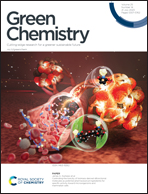On the reduction of CO2 footprint via selective hydrodeoxygenation by ZnO–Ti3C2Tx catalyst under solvent-free conditions†
Abstract
Biomass-derived fatty acids are essential feedstock for producing liquid fuels and value-added chemicals with significantly low CO2 footprints. Herein, Ti3C2Tx and ZnO–Ti3C2Tx catalysts were synthesized and demonstrated for the selective hydrodeoxygenation reaction (HDO) of methyl oleate (MO) as a model compound. The synthesized ZnO–Ti3C2Tx catalyst showed 100% conversion of MO with >90% selectivity for the HDO product (n-C18). In addition, the pure Ti3C2Tx demonstrated 100% conversion with a selectivity of 67% for n-C17 hydrocarbon via the decarboxylation route. The highest reduction of CO2 footprint is achieved at 280 °C and 30 bar H2 pressure under solvent-free conditions using ZnO–Ti3C2Tx. The catalyst is recyclable and reusable for five test cycles. The high catalytic selectivity of the ZnO–Ti3C2Tx catalyst towards HDO is attributed to the synergic effect of the Ti and ZnO active sites and the thermally stable structure. This study offers an efficient route for converting edible and non-edible vegetable oils to biofuels by controlling CO2 production.

- This article is part of the themed collection: Celebrating the scientific accomplishments of RSC Fellows


 Please wait while we load your content...
Please wait while we load your content...